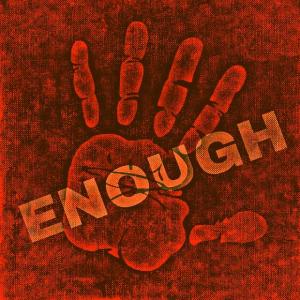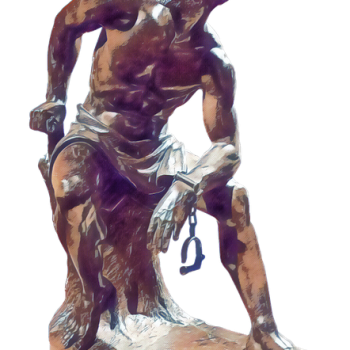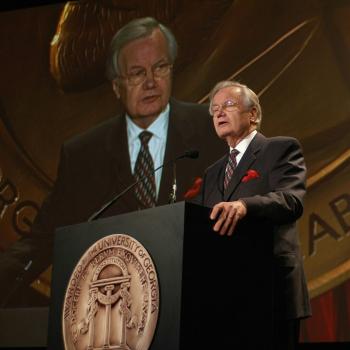
A Deep Hatred
February is Black History Month, and although I’m not a person of color, I want to talk about racism in America. More specifically, I want to ask this question: Can we ever heal America’s great racial divide?
I have never been the target of racial hatred, but I was involved in a small incident in which people I cared about were targeted. In the scheme of things, it was no more than a tiny, ugly ripple, but it reflected a greater evil that has consumed the U.S. since before the country existed.
Keep in mind that in the 19th century the U.S. fought a bloody civil war over racism (e.g., slavery), which cost 620,000 American lives. The shocking death toll was more than all of the American deaths in World War II and World War I combined (521,915). While the civil war ended slavery, it did little to change people’s hearts.
I’ve written several articles about racism in general and antisemitism in particular because it’s a subject that greatly disturbs me. Those articles include “Racism & Radicalized Christianity in America,” “For God’s Sake Christians, Pull the Plug on Hatred and “As Antisemitism Reaches Crisis Level, Christians Must Fight. Here’s How.”
The Great Racial Divide
My story took place in the American South in 1955 when I was about five years old. The small town where I lived was friendly and welcoming as long as you were white, straight and Protestant, which was typical of small southern towns at the time.
The U.S. Supreme Court had ruled only one year earlier that the long-held “separate but equal” doctrine was unconstitutional. Separate but equal was federal law because of a racist Supreme Court ruling in 1896 known as Plessy vs. Ferguson.
Plessy vs. Ferguson stemmed from an 1892 incident in which a man named Homer Plessy bought a train ticket in Louisiana. The problem was that Louisiana state law required blacks to sit in different cars than whites, and Plessy was one-eighth black. When he took a seat in a whites-only train car, all hell broke loose.
Plessy was arrested, and his case went to court. It wound its way through the court system until it reached the U.S. Supreme Court, the law school said.
The court’s ruling was a victory for segregationists. States and local governments could not only keep and strengthen existing segregation, but also pass new laws.
In handing down the Plessy ruling, the highest court in the country said blacks should be treated equally but separately. It should surprise no one that the treatment wasn’t equal.
Finally, in 1954 a new Supreme Court recognized that fact in its Brown vs. the Board of Education decision. In this case, the court ruled that schools for African American students were inherently unequal.
It was the beginning of the end of segregation laws – or at least I hope it was. Given the current Supreme Court’s radically right-wing majority, I fear that Brown will eventually be overturned. If the U.S. continues to elect fanatical right-wing candidates to office, it will happen.
An End to Segregation?
At any rate, the Brown vs. the Board of Education ruling didn’t appear to make any difference in my small hometown. Blacks and whites remained segregated, and that was that.
Whites lived inside the city limits, and African Americans lived in Buck Town on the outskirts of town. It was such an ugly name for a community, but it defined my town’s white supremacist mindset in the 1950s.
Blacks apparently had their own churches and shopped in their own stores. They were invisible to families like mine. Nor would I attend school with black students until the late 1960s, when my high school was peacefully integrated. (That’s a whole other story.)
Before then, African American children were bused to black schools two counties away. My mother said it was a two-hour bus trip, as compared to my 10-minute walk to school.
But none of the racial undercurrents were apparent to the five-year-old me. Blacks and whites lived such segregated lives that I was barely aware of their existence. In fact, the only black person I had ever seen was the African American woman who cleaned an elderly neighbor’s house.
I didn’t realize that evil existed in my world. The society in which I lived demanded the invisibility of African Americans, gays and others who were not white and straight. The consequences for fighting society’s unwritten rules could be quite serious.
First Friends
My first brush with racism occurred the summer before I started kindergarten. At the time, my sister and I were the only children on our block. She was still crawling around in diapers, which meant that I had no playmates.
I was quite lonely until one day when I noticed two children playing in the front yard where the black housekeeper worked. They looked to be about my age, and I could barely contain my excitement. (I think my mother was happy that I had the opportunity to make friends with children my age.)
At any rate, my mother talked to the children’s mother and invited the little boy and girl to play with me. Their mother agreed, but said the children had to stay in my front yard where she could see them. No problem.
Before I knew it, the little girl and her brother were playing on my swing set. They brought their paddle balls and some chalk, and I brought a few toys outside. We were set!
It was amazing. The little boy, whose name I can’t remember, did just about every move one could do with a paddle ball. They also drew hopscotch boxes on the sidewalk and taught me this new game. And we played with my toys.
I had friends!
A Sad Ending
Then suddenly, they were gone. Not entirely gone. I could see them playing in my elderly neighbor’s front yard while their mother cleaned his house. But they could no longer play with me in either yard.
No amount of crying changed the situation. I concluded that I had done something wrong, but I didn’t know how I had disobeyed. I hadn’t lured the children into my house or backyard, and we hadn’t gotten into trouble with my mother.
Unbeknownst to me, the great racial divide had made its presence felt.
I know it must have been difficult for my mother to see my distress, but after I learned the truth, I understood her evasions. Looking back, I wonder whether the children’s mother was any more forthcoming with them than mine was with me. How did she handle the situation?
The Truth Comes Out
I discovered the truth when I was entering my teen years and overheard part of a conversation that I wasn’t supposed to hear.
The problem was the children’s skin color. I was white, and they were black. It was as simple and as complicated as that.
My anger turned toward the villain in this story, who was the woman who lived directly across the street from me. She had stood at her living room window every day and watched my friends and me play right under her nose. Rather than mind her own business, this racist b***h saw one white child playing with two black children and had a meltdown.
We weren’t her children (thank God!), and we were playing in a yard that wasn’t hers. Yet, she felt entitled to insert herself into the situation by threatening the black woman and her children.
Everyone on the block apparently knew the story except for me. And I was quite angry. Racism was a hard lesson for me to learn. However, I also came to realize it was undoubtedly a much harder lesson for my friends who were the targets of a racist b***h.
Trying to Make Sense of Nonsense
Hating someone because of their skin color made as much sense to me as hating all redheads because of their hair color or despising everyone who had freckles because … well, just because….
One thought bothered me more than any other. A person’s skin color should make no difference to Christians. I attended church with the b***h, who loudly proclaimed her Christian faith and heard the same sermons she heard about loving your neighbor.
Even at 13, I wondered about the disconnect and began to wonder — for the first time — about the church I attended. That one doubt was followed by other doubts, and when I left for college, I left my childhood denomination, never to return.
I may be wrong about many things, but I don’t believe I’m wrong about the conclusions I reached as a teenager. Genesis 1-2 doesn’t tell us whether early humans were black, white or some other color. The Bible says God created us in his image, and he saw his creations were “good.”
People are the ones who make distinctions because of color, religion, culture or other traits. God created the human race – not racism – and he makes no distinctions between us.
The Resurrection of Hatred
My first friends faded from memory, but were resurrected in my mind in 2016.
That was the year a despicable man named Donald Trump resurrected the hatred that some Americans feel for other people because of skin color, gender, sexual orientation, religion or whatever else eats at their souls. The hatred came so quickly to the surface that it must have been festering just out of sight for decades.
The 2016 election angered me, but it also reminded me of my first friends and made me wonder….
- Why did one racist neighbor have so much hatred in her heart that she prevented three innocent pre-school children from playing together?
- Who gave her the power to interfere in other people’s lives?
- Why do so many Americans feel the way she felt?
- Why did so many of my neighbors vote for a racist, misogynist narcissist for president, and why do they continue to support him now?
- Why can’t Americans heal the great racial divide?
What Christ Expects of Us
These voters are the same people who shout their Christian faith from the rooftops, but they really don’t have any understanding of what Christ expects of us.
Please excuse my judgmental attitude. It’s un-Christian, and I know it. But this is what I also know….
Christ sought out people that his society hated including tax collectors like Matthew (Mark 2:15-17, ESV) and the adulteress he forgave and told to sin no more (John 8:1-11). We also need to remember his parable of the good Samaritan, who helped a Jew despite being despised by Jews.
Additionally, Christ made a point of reaching out to people that the society of his time belittled or ignored.
He healed a crippled old woman on the Sabbath, saying, Woman, you are freed of your disability (Luke 13:10-17, ESV). Like my racist neighbor who had a meltdown about race, the Pharisees had a meltdown at the thought of breaking the law by working on the sabbath.
Christ blessed people who had nothing to offer him in return when he called a group of children to him. Mark 10:13-16 says his disciples rebuked people who brought the children.
Christ responded by saying, ‘Let the children come to me. Do not hinder them, for to such belongs the kingdom of God. Truly, I say to you, whoever does not receive the kingdom of God like a child shall not enter it. And he took them and blessed them, laying his hands on them.’
To any American who says we are God’s new chosen people, I say, Think again.













